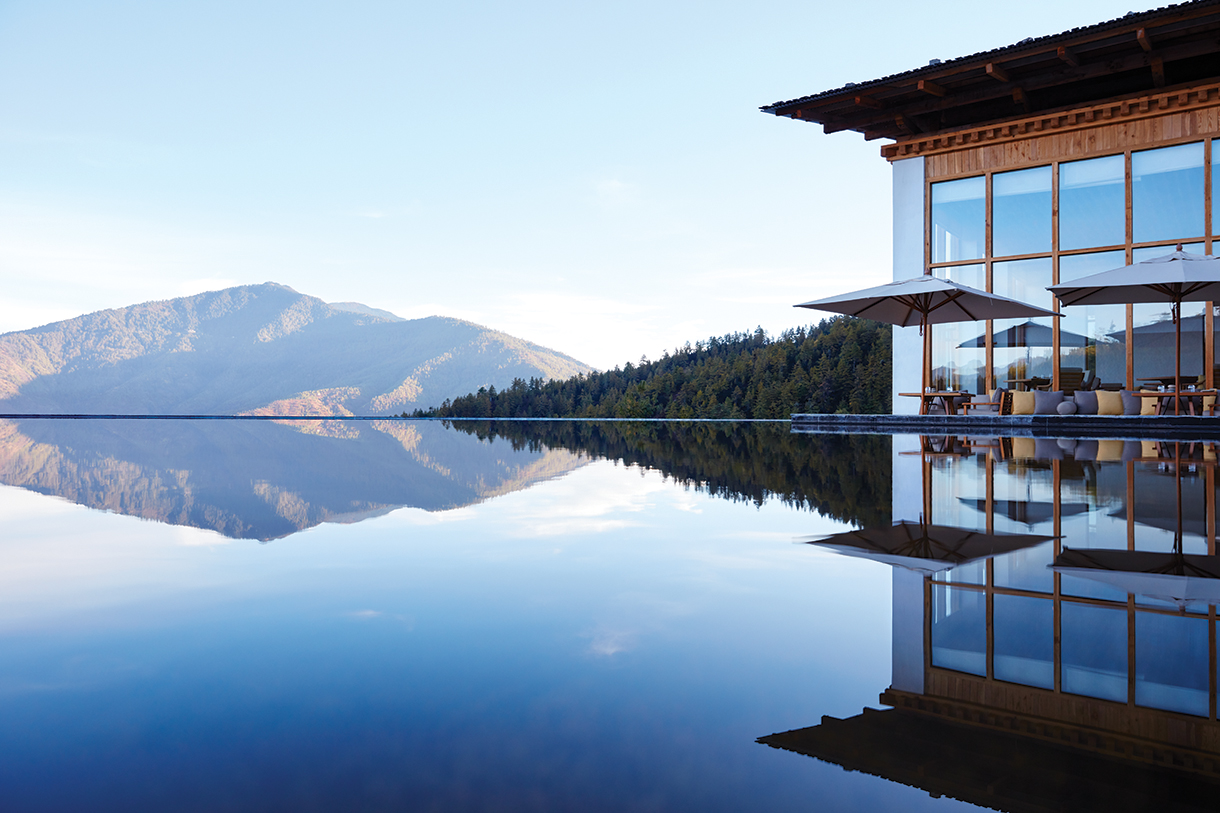
The Magic Kingdom
Time has stood still in Bhutan—until now.
There is a seventh-century temple near Paro, Bhutan, with a quiet little courtyard guarded by two mandarin trees. The trees have provided shade to passing visitors for centuries, but that’s not what’s interesting. The remarkable thing is: They bear fruit all year round. Spring, summer, autumn, and winter, the branches remain heavy with small, ripe oranges. In a country like Bhutan, a mythical place of thunder dragons and flying tigers, of folkloric reincarnated holy men and mountain yetis, it’s just another fanciful miracle.
This little, land-locked mountain kingdom, tucked into a corner of the Himalayas between Nepal, China, and India, was more or less cut off from the outside world until the 1970s, when King Jigme Singye Wangchuck, known as the Fourth King, decided it was time to open the country to tourists. He did this strategically, enforcing a minimum daily fee of $200 for all visitors and requiring they enter via a package tour. The government-controlled system raises funds for the free education, health care, and social services Bhutan provides to its 770,000 citizens—while outsiders enjoy the magical experience that Bhutan so graciously puts on. But there was a loophole for regional tourists, a free pass open to anyone coming from India, Bangladesh, or the Maldives.
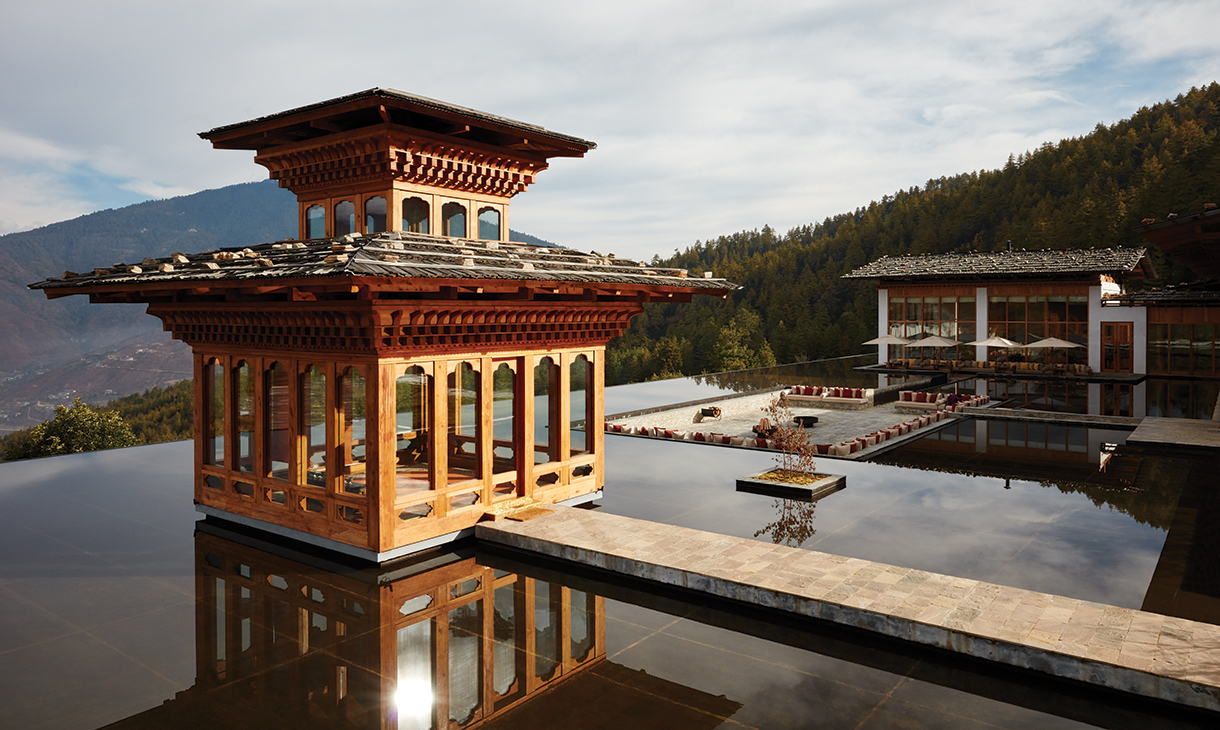
The drive to Thimphu, the capital, takes about an hour. The sleepy grid of traditional low-rise, whitewashed houses with roofs painted green, red, or yellow is the only capital in the world without a single traffic light. Instead, a traffic cop stands at the main crossroads directing the orderly cars with his white gloves. There are lots of rules in Bhutan—not the least of which is that houses must be built in the same traditional style. Even clothing is regulated. Locals must wear national dress for work, school, and anything official, which accounts for most hours in a day. For men, this is the kita, a tunic worn with a belt over knee-high socks. Ladies wear the kira, a long, wraparound skirt and colorful jacket. Tourism guides, who must accompany visitors throughout their trips, dress like this, even when hiking. When off-duty, they are allowed to wear whatever they like.
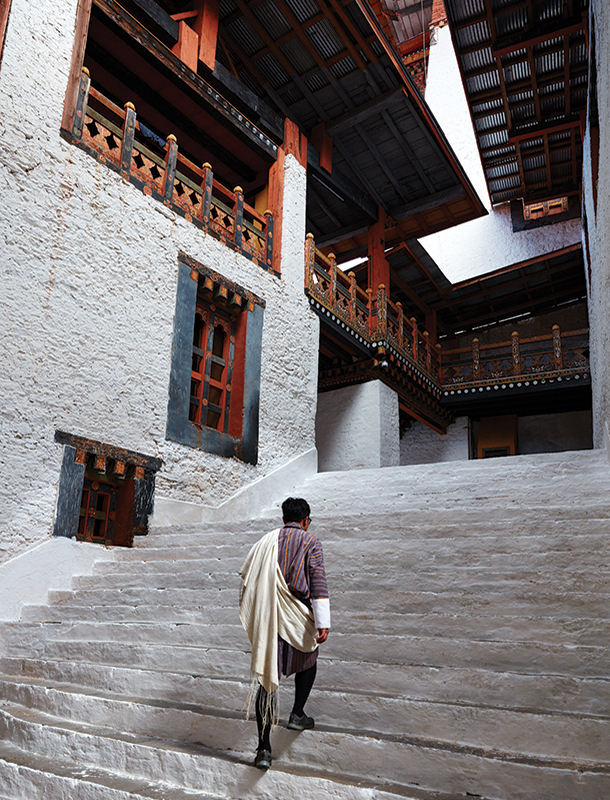
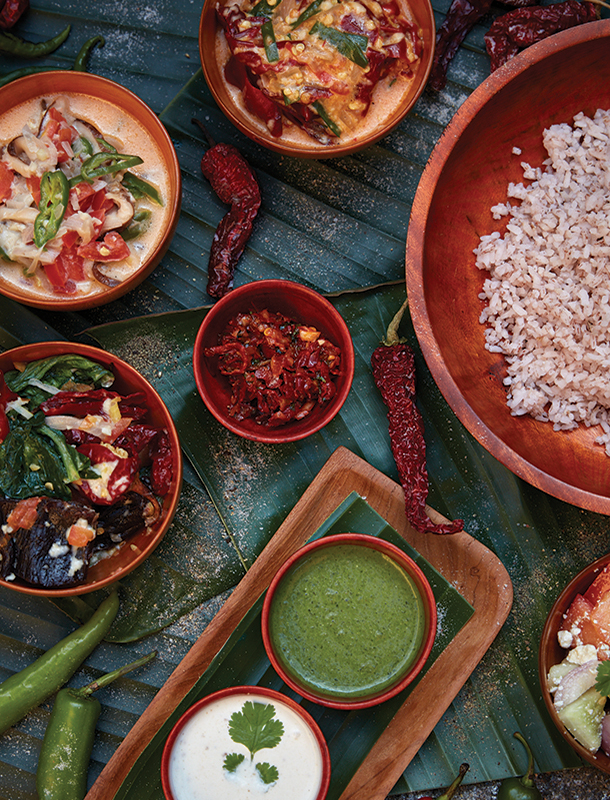
Inside, find air heavy with incense and museum-like pieces—golden pillars, huge Buddhas, and thangka paintings of deities, lotus flowers, and swirling clouds. While monks recite mantras, locals come in to prostrate and offer small gifts of money, fruit, or biscuits. The wooden floors are worn smooth by centuries of footsteps, and there are photographs of the country’s religious leader, Je Khenpo, on the walls. He is believed to be a reincarnation of the one that came before, who was a reincarnation of the one that came before, and so on, leaving little room for myth to be separated from reality.
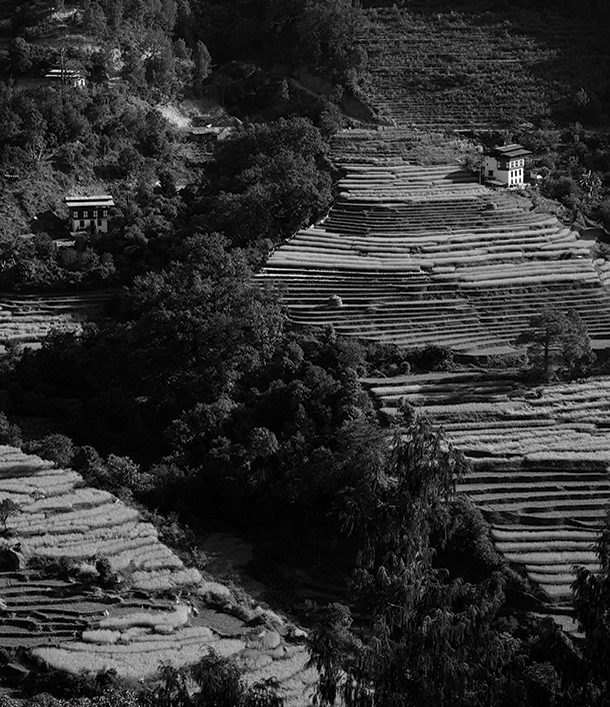
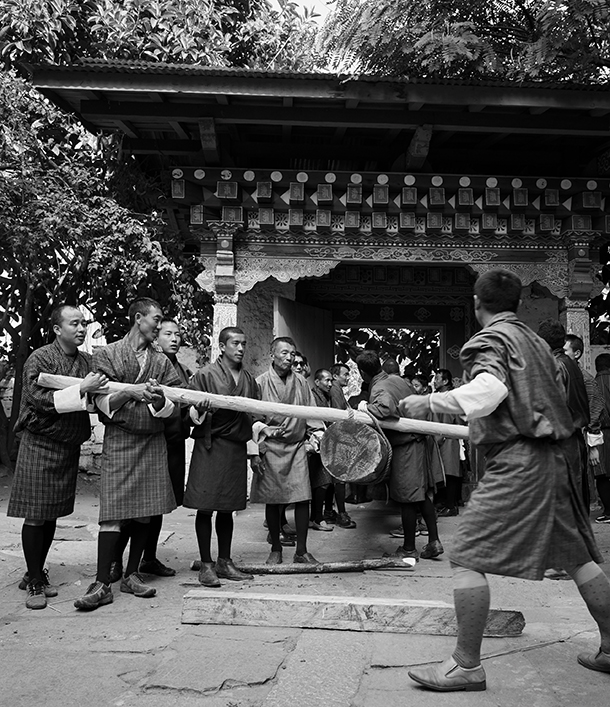
From town, the road winds up the hillside to Six Senses Thimphu, the brand’s flagship Bhutanese lodge opened in April 2019. A small army of kita- and kira-wearing staff welcome guests with traditional silk scarves and usher them into the lounge, where lofty timber ceilings and traditional bukhari fireplaces frame sweeping valley views. Wispy clouds partially obscure the rolling hills, with Thimphu sitting way below and a giant gold Buddha gleaming just across the valley. Pass reflective pools and the traditional prayer pavilion room (where a passing monk may lead an impromptu meditation session) on the way to bedrooms big enough to do cartwheels in—timber-clad and warm, with huge beds and stone bathrooms overlooking the panoramic valley views.
Guides like Tashi Chimpo are assigned to guests for their entire circuit. Chimpo, a neat, cheerful woman, is happy to answer endless questions—anything from religion and history to how to make the best chili and cheese (the traditionally spicy national dish).
Cheerfulness is a natural trait—in 1972 the Fourth King declared that “Gross National Happiness is more important than Gross National Product.” Locals report that they don’t mind the rules because they help preserve their cultural heritage. Bhutan held its first democratic elections in 2007, yet the current Fifth King is fervently defended and his picture is in every home, office, and restaurant—not because that’s another rule, Chimpo reports, but because he is so popular.


On the forested walk to Thimphu’s giant Buddha, built in 2015, Chimpo follows a path that traces the valley, winding past strings of fluttering prayer flags. Birds and butterflies fly above wild boar and Himalayan bears, although the mammals are rarely seen. In spring, the path is lined with ferns, wild roses, and mint; April brings out the rhododendrons; winter sees clear skies and mountain views. Protecting the environment is paramount here, as Bhutan is famously considered to be the world’s only carbon-negative country.
Good weather makes the drive over Dochula Pass prime for cinematic views of Himalayan peaks—some reaching 23,000 feet. Past villages and swathes of blue pines, Dochula appears with its 108 white stupas before the road drops down into a different world of steamy, dense forests dripping with moss and cloud-filled turns hiding the valleys of Punakha below.
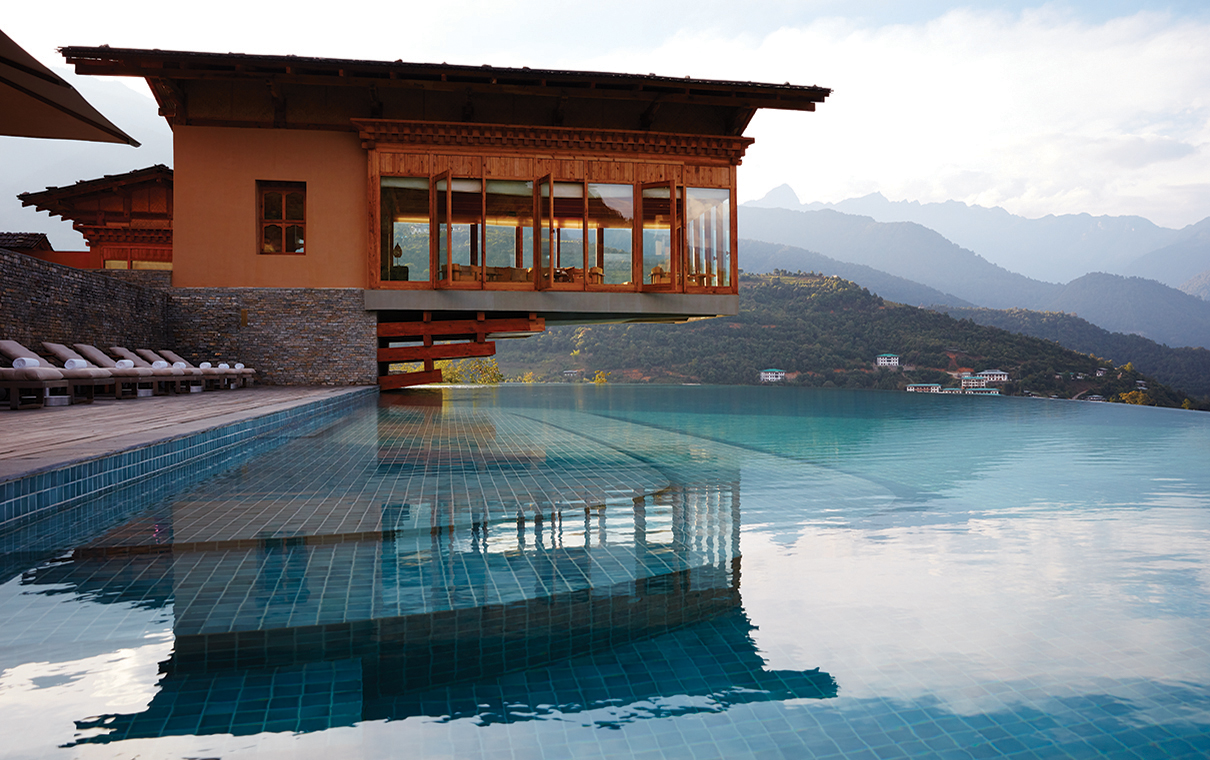
Punakha is warm and tropical, a place of lush orchards and neon-green paddy fields. Here, the Six Senses Punakha lodge is a more intimate affair, with villas dotting the hillside looking onto the steep hills and a remarkable infinity pool with a farmhouse-style lounge cantilevered above it. Here, Chimpo takes a path between rice paddies, past small farms, and up through thick forest to the 17th-century Chorten Ningpo temple. This weird, mystical place where butter lamps glow before the Buddha statues is made more so by all of the rumors. Locals will say in all seriousness that yetis are rare but are known to have pockets on their backs perfect for carrying off little girls. Boys are less lucky, they say; they get killed (not eaten, though, because yetis are vegetarians). Yetis are probably just albino bears, but that’s not the point; it’s otherworldly enough here to believe almost anything.
Even more intriguing than yetis, at least to prudish Westerners, are the paintings of giant, colorful penises, often with wings, that appear on houses around the fertility temple of Chimi Lhakhang. The temple is dedicated to Dukpa Kunley, the Divine Madman, who was a 15th-century Tibetan missionary and monk famed for his love of wine, women, and his penis, from which he shot fire to subdue troublesome demons. Today the phallus is revered, and souvenir shops sell it as charms and sculptures. In the temple, local women walk around with a giant wooden phallus resting on a shoulder, a ritual said to help with fertility problems.

Drive back over the Dochula Pass to Six Senses Paro, a stone-clad lodge built high in a pine forest, just next door to the ruins of Chubjakha Dzong. There is a serious spa here, as in all Six Senses properties, offering treatments, yoga, and guided meditation, or guests can stroll to a tiny monastery for a private, candle-lit meditation session. Dinner can be arranged in a nearby traditional farmhouse, home to a cheery old refugee couple from Tibet, with a dance performance from a local troupe. Bhutanese food is universally delicious, especially for those with a taste for heat; chili comes with everything: steamed momo dumplings, chicken with coriander, dried pork with radishes.

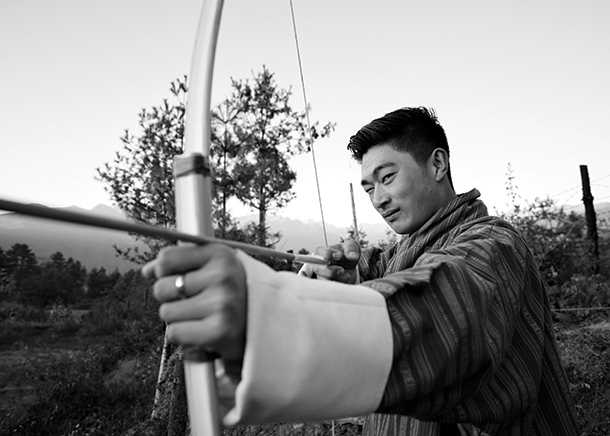
In mountain country, trekking can range from a gentle afternoon stroll to a 10-day expedition over snow-covered peaks. The payoff of the 2.5-hour climb to Paro Taktsang (better known as Tiger’s Nest) is witnessing the 17th-century monastery clinging to a cliff face at 10,240 feet. It is, quite literally, breathtaking—Bhutan’s absolute highlight. This is where Buddhist leader Guru Rinpoche flew in from Tibet on the back of a tiger (this will be relayed as fact), and the destination’s bucket-list status requires visiting early for a clear path up through ancient oak forests. Stop halfway at the little café for a cup of chai and a gape at the monastery, which seems to float in the clouds above. Up hundreds of stone steps, past the foot of a towering waterfall, it’s revealed that Tiger’s Nest is really a network of dark, intimate temples where monks go about their days completely ignoring visitors.
Sit quietly and observe as they burn incense, or chant, or blow curiously long and loud trumpets. It’s like passing through the pages of a vintage National Geographic, a strange suspension of time that will be over by noon.
The modernity comes rushing back in the form of hundreds of Indian tourists, who bus in for a few days’ sightseeing. Regional tourism spiked at 200,000 in 2018, compared to 50,000 in 2014. New budget hotels are under construction and ancient sites are increasingly crowded as the government scrambles to maintain the magic of its tranquil brand.
When it gets busy, it’s time to climb back down to the valley for a well-deserved massage and snooze before the next reality, flying home, hits hard. Sit on the right-hand side of the plane for the hair-raisingly sudden climb up through steep valleys for a glimpse of Mount Everest towering above everything—just another miracle, yet this one is more than fanciful.

THE DETAILS
Getting There
Book a seven-night trip with Lightfoot Travel (lightfoottravel .com) from $6,456 per person, including international flights from New York to Paro via New Delhi, all transfers, two nights each at Six Senses Thimphu, Punakha, and Paro, and a night at Taj Palace New Delhi on the return journey. Accommodation in Bhutan is on a full-board basis, and the price includes the visa and mandatory daily fees.
Drukair (drukair.com.bt) operates daily flights to Paro from Bangkok and Calcutta, five flights a week from Kathmandu and New Delhi, and twice-weekly flights from Singapore.
Sleep
Opened in 2018, Bhutan Spirit Sanctuary (bhutanspiritsanctuary.com; from $650, all-inclusive, including wellness and activities) is located in the Neyphu valley, in Paro. The 3-foot-thick walls and interior courtyard are inspired by the traditional architecture of the dzongs, with huge guest rooms looking out over the valley and onto the Eutok Samdrupcholing monastery.
Built in 2013 to blend in with surrounding farmhouses, the 12-suite Gangtey Lodge (gangteylodge.com; from $470) has a luxed-up local design. The lodge prides itself on its strong sustainability initiatives and has astonishing views over the Gangtey valley, famous for its protected black-necked cranes.
Amankora (aman.com; from $1,440, all-inclusive) was the first luxury outfit to open in Bhutan, back in 2003, operating five lodges: Paro, Thimphu, Punakha, Gangtey, and Bumthang. The design of the lodges is a typical Aman-style blend of traditional and contemporary, with excellent spas offering fully immersive wellness journeys.
COMO Hotels (comohotels.com; from $606, including breakfast) has two Bhutanese lodges, Uma Paro and Uma Punakha, as well as a luxury camping route that leads guests through the Paro valley to Thimphu, and then on to the Punakha valley.
Six Senses (sixsenses.com; from $1,010, including breakfast) operates four new lodges in Bhutan: Thimphu, Punakha, Paro, and Gangtey. Bumthang will open in March 2020.
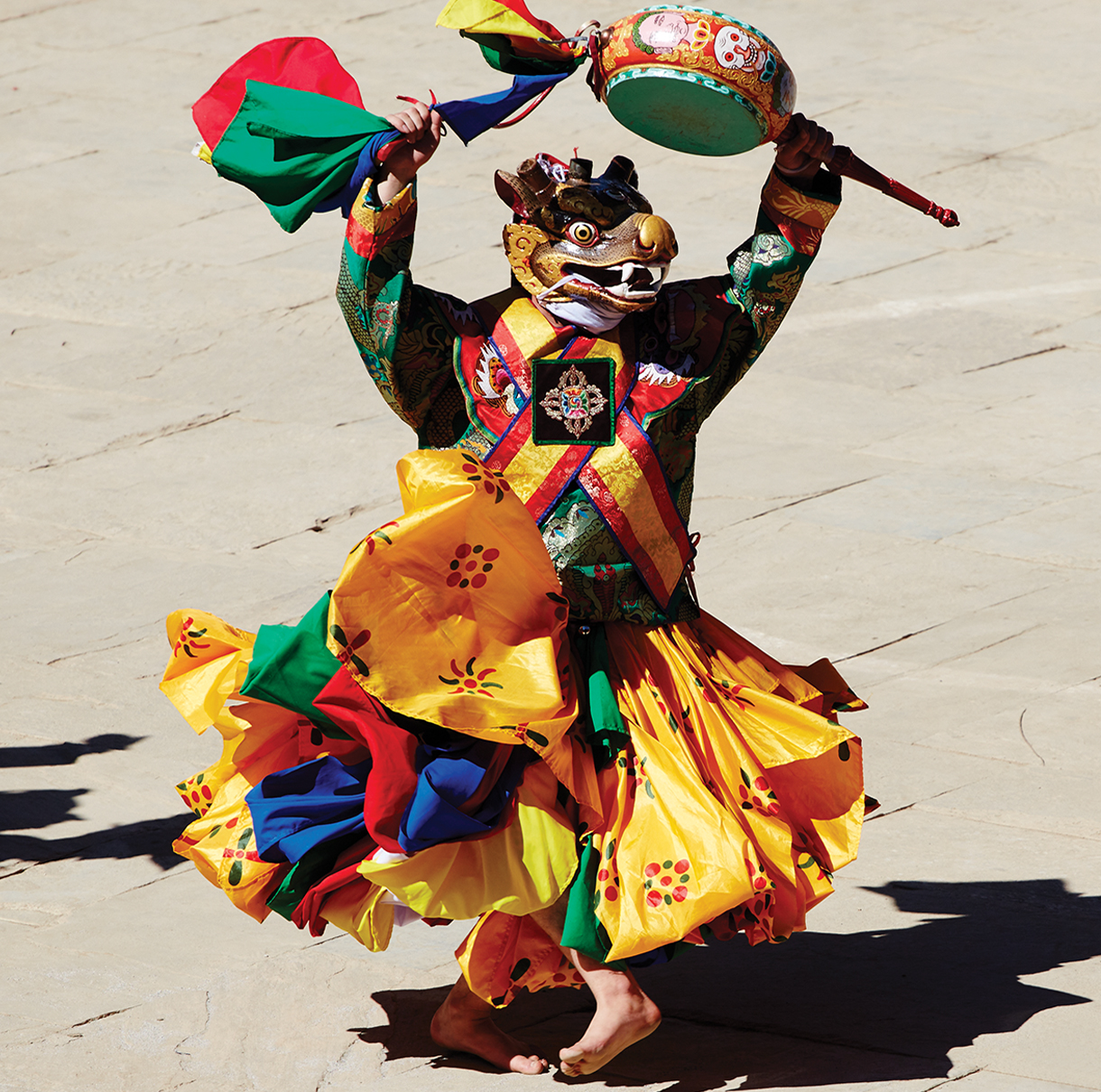
When to Visit
Spring is all color, when the valleys erupt in the blossoms of the famous rhododendrons and jacaranda trees. Summer can see warm, wet days, as well as fewer tourists, making it a good time for sightseeing. Autumn is still warm and pleasant, with the turning leaves lending everything a colorful hue. Winter sees clear skies, cold nights, and snowy peaks, with spectacular star-gazing at night. Festivals are hugely important in Bhutan, with the largest, Paro Tshechu, taking place in March and attracting thousands of locals dressed in colorful brocade costumes and painted masks to dance and reenact famous legends. The Black-Necked Crane Festival in November celebrates the annual return of the endangered and revered birds to the Gangtey valley.
Altitude
Bhutan is, on average, 8,000 feet above sea level, with most visitors not straying beyond 10,000 feet. As such, serious altitude sickness is rare, although visitors are likely to feel the effects on arrival and will need several days to acclimate. Avoiding exertion on the first few days, keeping hydrated, and paying attention to hiking advice from guides, especially during the Tiger’s Nest hike, should avoid any problems.




